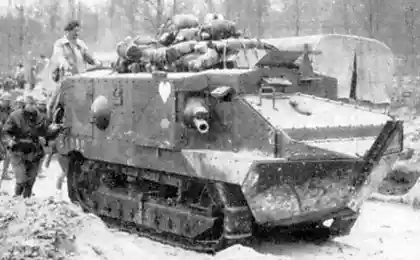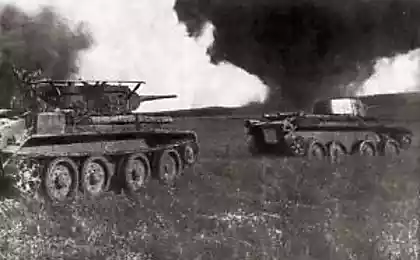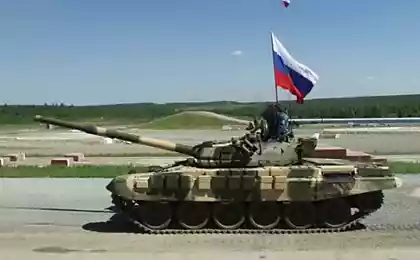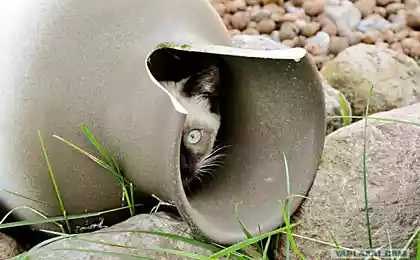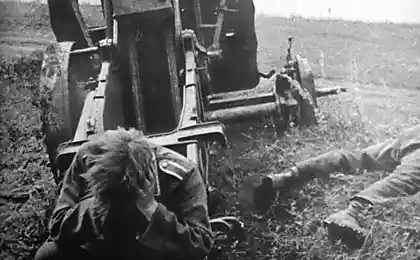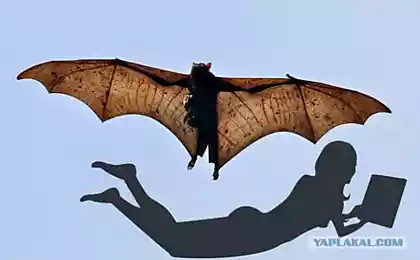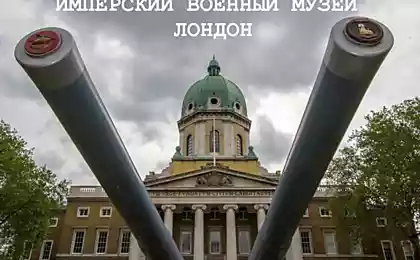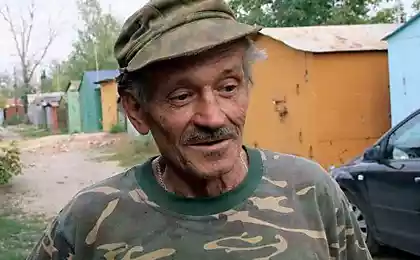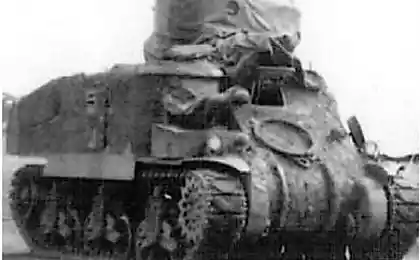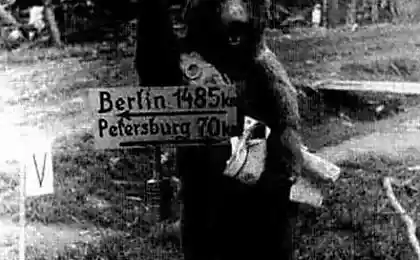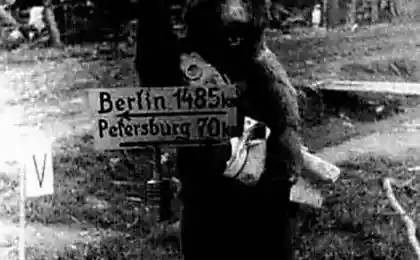1087
Tanks felines., Part 2
Tanks felines. Part 2 - Panther
18 photo and text via liveguns.ru/tanki/pantera4
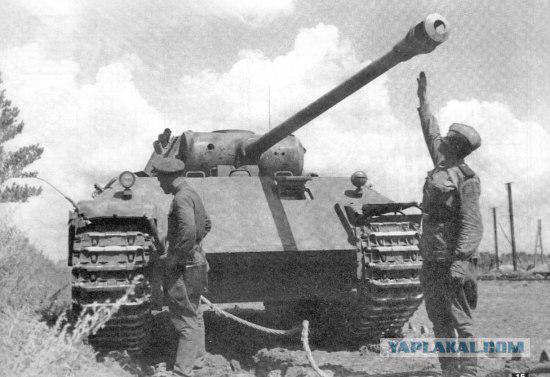
2 ...

3 ...
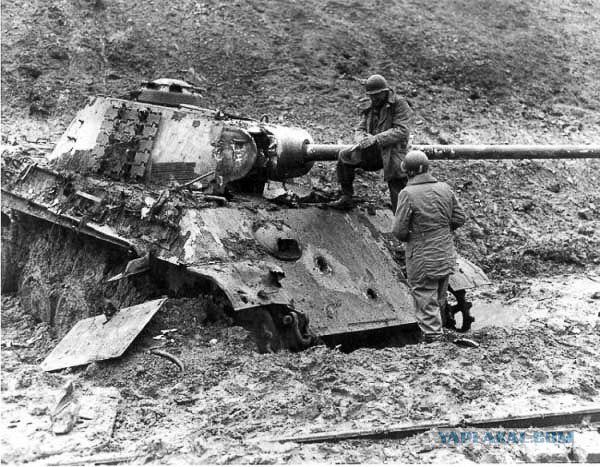
4 ...

"Panther" - surely one of the most famous heavy tanks, took part in the Second World War. The catalyst for the creation of an unforeseen system tank weapons of the Wehrmacht war machine became a Soviet medium tank T-34. His appearance on the Eastern Front forced the Ministry of arms of Germany to suspend the work, which in 1937 led the company Nepschel on future tanks 30-ton class. July 18, 1941 Rheinmetall company received an order to develop a 75-mm long guns, able to penetrate 140 mm armor at a distance of 1000 m. On November 25, companies Daimler-Benz and MAN was, in turn, issued an order for a 35-ton tank. The performance requirements for new combat vehicle defined as follows: width up to 3150 mm height-2990 mm, engine power 650-700 hp, armor zaschita- 40 mm, maximum speed - 55 km / h. Quest received the code name - "Panther».
Tank, designed by Daimler-Benz, externally strongly resembled the T-34, but still liked Hitler. From the Soviet machine was completely copied layout with rear-engine-transmission-th branch and the drive wheels. Eight large-diameter road wheels arranged in a checkerboard pattern, blocked two and had a leaf spring as the elastic member of the suspension. Intended to be used on the tank diesel engine Daimler-Benz MB 507. In early February 1942 began the construction of a prototype - VK 3002 (DB), and four weeks later, Hitler ordered the Minister of Armaments Speer to give the company an order for the first 200 cars. However, the point of view of the Fuhrer did not find understanding and support of the Ministry of weapons experts who not without reason to believe that at the front conditions resemblance to the T-34 could cause the tank shelling of his own artillery. The project company MAN, a German who had a traditional layout with front-transmission and drive wheels, it seemed preferable, although it was much more difficult. These differences led to the formation of so-called "Panther-Commission" 13 May 1942 Hitler was informed expert opinion on both projects; This preference is clearly given to the tank company MAN. The Fuhrer was forced to agree with the experts, but then put forward its own terms: the first car to be produced in July, and the next two - in August 1942. The price of one tank without arms was 117,000 Reichsmarks (compared PzIII cost 96,163 and "Tiger" -250 800 marks).
Designers PzKpfw V (known as "Panther", without mentioning the army entered the index on the orders of the Fuhrer's only February 27, 1944) was the chief engineer of the department of MAN tank P.Vibikke and engineer G.Knipkamp of management improvement and testing of weapons.
The first two tanks V1 and V2 (V - Versuch - experience), differ from each other in minor details, produced by September 1942. November 3 one of the machines, with the layout instead of this tower, Speer demonstrated on the training ground in Bad Berka. During the tests revealed significant shortcomings in the chassis. Their elimination would take time, and this delayed the start of serial production. Order also provided to produce 250 tanks in a fairly short period of time - to May 12, 1943. In addition, it received an unexpected order to arm Hitler "Panther" 75-mm cannon with a barrel length of 100 calibers. Fortunately (for the Germans, of course), this gun was not ready and the serial production of the tank indication Fuhrer did not stop much.
The first production "Panther" left the factory workshop of MAN January 11 1943. Tanks "zero" series (20 points) received the designation Ausf A. They had nothing in common with similar machines, produced from September 1943. A characteristic feature of the first serial "Panther" was the commander's cupola with the tab on the left side of the tower and single-chamber muzzle brake gun. The tanks are equipped with engines Maybach HL210P45 and had a frontal armor thickness of 60 mm. They were used only in the rear for crew training. Since February 1943 marking machines of this series has changed on Ausf D1.
So far we can not say exactly why the first modification of the Large series "Panther" received the designation D. Perhaps the letters B and C reserved for other options.
Tanks PzKpfw V Ausf D (from this and subsequent versions of the index through notation armored Wehrmacht was the same - SdKfz171) slightly different from the prototypes and machines "zero" series. The changes affected mainly commander's cupola and gun muzzle brake - they become more familiar "panterovsky" appearance. The thickness of the frontal armor increased to 80 mm. On tanks installed and a new gearbox type AK 7-200.Sleduet noted that the machines release of the first half of 1943 was similar to the commander's cupola turret "Tiger", later it was replaced by a new one, with seven periscopes surveillance on the perimeter and a special ring installation of anti-aircraft machine gun MG 34. 5 ...

The sides of the tower were mounted mortars NbK 39 to launch smoke grenades caliber 90 mm.
Armor tanks fired in the second half, covered "tsimmeritom" In addition, they were equipped with bulwarks, made of 5-mm armor plates.
The characteristic features series machines D (officially D2) is the lack of ball set a course gun (it was placed inside the tank, and only for the shooting was inserted into a narrow vertical slit, closes the hinged lid), as well as the presence of the left side of the tower round hatches to eject spent cartridges and loopholes for shooting from the sidearms in the sides and stern bashni.V 1943 started designing another modification "Panther» - Ausf F, which is significantly different from previous models. The most important innovation was the tower, dubbed Schmalturm («narrow" or "close the tower"), which was less than the standard and had a different design.
In the course of 1944 it constructed and tested several prototypes. Designing ended only in January 1945.
As a result, the thickness of the turret was: forehead - 100 mm, board and food - 50, roof - 30. In the frontal still remained loophole for telescopic sight TZF 13. The final version of the frontal armor increased to 120 mm, on-board - to 60, and the armor of the roof - up to 40 sets a new stabilized periscope sight TZF 1 and stereoscopic rangefinder company Zeiss. Rangefinder with a base of 1320 mm and a 15-fold increase was located in front of the tower, on the sides of which were armored caps for his eyepiece. Cover and installing night vision device FG 1250.
Mask gun type Saukopfblende («pig snouts") thickness of 120 mm was similar to that applied in the tank "Tiger II».
Innovations did not pass and armament. And if the gun has remained the same and was just upgraded factories Skoda - she lost her muzzle brake and received index KwK 44/1, the MG 34 machine gun turret replaced by MG 42. Instead of a course machine gun was mounted machine MP 44. Installation weapons in the tower at the factory Krupp and Skoda.Izmeneniya affected not only the tower, but also the body. The thickness of the roof increased from 17 to 25 mm, the driver changed the hatches and arrow-radio operator.
Test and two new engines: Deutz T8M118 700 hp (515 kW) and Maybach HL 234 with direct fuel injection and 850 hp (625 kW).
By the end of the war there was not a single prototype in final form, though mass production scheduled to begin in June 1945. In the beginning, the company Daimler-Benz brought together the chassis, which established a standard turret from Ausf G. In turn, "close the tower" installed on the chassis Ausf G and tested in Kummersdorf. Total for "Panther» Ausf F produced 8 blocks and 2 towers.
In February 1943, were developed tactical and technical requirements for the tank "Panther II», involves a high degree of unification of tanks "Tiger II» and "Panther". Implement it was simply because the plants Henschel produced on both types of machines.
On the "Panther II» to be used "close the tower" and a new building. His frontal armor reached 100, onboard - 60, and aft - 40 mm. Weapons - 88-mm cannon KwK 43 L / 71. Since in this case the mass of the tank exceeds 50 tonnes, the question of a new power plant. As variants considered Maybach HL 234 engines, Simmering Sla 16 (720 hp) and MAN / Argus LD 220 (700 hp). In 1945, for the "Panther II» started designing a new tower with 150-mm frontal armor.
Neither of the two prototypes was not completed. Until more or less high degree of readiness brought one chassis, the addition of a tower from Ausf G. It is interesting to note that, in parallel with the design "Panther II» was being developed tank E-50, called her zamenit.V during work on the Ausf F and "Panther II »firm Krupp twice offered options for re-usual" Panther "cannon KwK 43 L / 71 caliber 88 mm, but to no avail. He remained on paper and draft equipment "Panther" 100-caliber 75-mm cannon with a muzzle velocity of 1250 m / s.
Along with the creation of new versions based on linear tank "Panther" was issued and several special-purpose machines. The first of these was the Armoured Recovery Vehicle (ARV) Bergepanzer V or Bergepanther (SdKfz 179). It is no accident: new tanks to enter the army, and the means for their evacuation from the battlefield almost was not. The existing machinery was too weak -for towing tank "Tiger", for example, had to "harness" two 18-ton tractor Famo.
Order BREM issued May 7, 1943, and a month later the company began producing MAN chassis Ausf D, designed to her. The first batch BREM (46 cars) did not have a crane and winch, but very soon the factory Henschel in Kassel have been designed and manufactured crane and winch with a pulling force of 40 tons and a length of rope 150 m. The selection of power produced by the engine of the tank, aft who had two folding UPR-ra-opener designed to hold the car in place when operating the winch. During the last tow blocked. The tower was replaced with a loading platform for the transport of spare parts or disassembled units.
BREM issued on the chassis Ausf A and Ausf G, had enlarged fuel tanks. The upper front hull was mounted bracket for 20-mm cannon KwK 38, veiled shield of thickness 10-15 mm.BREM-Panther & quot; originally equipped with cranes of 1500 kg, 6000 kg and then. They were used mainly for removing engines.
In front of the BREM had two stops from the tabs of solid wood, for pushing a narrower machines.
March 1st, 1944 at the site of Bad Berka Bergepanther demonstrated Inspector General armored forces, Colonel-General G.Guderianu. April 7, Hitler gave orders for the monthly production of 20 cars. However, the real issue was in April 13 vehicles in May - 18 June - 20, and in July and only 10 total factory shops left 347 Bergepanther (in foreign literature found another number - 297). 6 ...
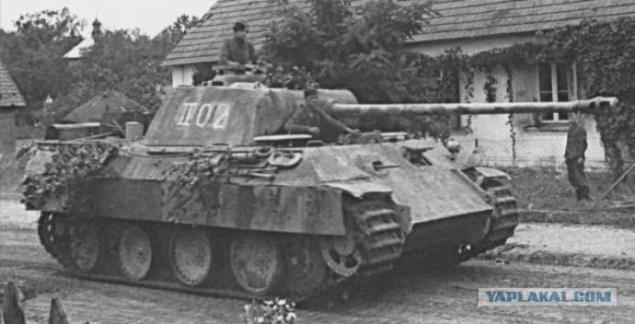
CHASSIS. tank for a board consisted of eight dual road wheels with rubber tires with a diameter of 850 mm.
Suspension - torsion. In order to obtain a large angle of twist torsion perform double that provided the vertical movement of the support roller 510 mm. Front and rear rollers supplied with hydraulic shock absorbers.
The leading position of the front wheels have two removable gear crown 17 teeth each. Engagement lantern. Between the drive wheels and the first support roller installed a pneumatic roller.
The guide wheels - cast, with metal shrouds and crank mechanism track tensioning.
Caterpillars steel, melkozvenchatye, odnogrebnevyh of 86 tracks each. Truckee cast, width 660 mm, pitch 153 mm truck.
ELECTRICAL. It was performed on a single circuit. Voltage 12V. Sources: Generator Bosch GTLN700 12-1500BJ1 capacity 0, 7 kW, two batteries capacity of 150 Amp-hrs Bosch Consumers: electric Bosch BFD624ARS15 capacity of 4, 4 kW, control devices, lighting scopes, devices sound and light signaling, internal and external lighting, hills guns and machine guns.
MEANS OF COMMUNICATION. All tanks "Panther" is equipped with radio Fu 5, which had a range of 6, 4 and 9 km of telephone, telegraph, 4 km.
SPECIAL EQUIPMENT. Fire suppression system - automatic. Alarm was put on the dashboard of the driver.
"Panther" would be replaced by a combat soldier tanks Pz III and Pz IV, but the pace of series production did not meet the needs of the troops. In the end, the inspector general of armored troops of the Wehrmacht Col. Gen. G.Guderian after consultation with the Minister of armament A.Shpeerom decided that re-new tanks to be only one battalion in a tank regiment.
The battalion consisted of four companies of 17 tanks each. At the headquarters on 8 tanks, combat engineer platoon and a platoon of air defense, armed with self-propelled guns Mobelwagen or Wirbelwind. There was in the battalion and technical company, complete with a variety of towing vehicles and evacuation vehicles. In practice, organizations often never match the state. In parts Panzerwaffe there were an average of 51 - 54 tank "Panther", and in the Waffen SS (Waffen SS) 61-64.
The first military units who manned the "Panther", became the 51 th and 52 th tank battalions. Their formation is completed by the 15 June 1943. They made the 10th Tank Brigade (Panther-Brigade 10). As part of the SS troops also formed a team "Panther».
Overall, in mid-1943 in operation there were about 240 tanks modification D.
The operation "Citadel" was attended by 196 tanks. Their combat debut was not successful - only for technical reasons, down came the 162 "Panther". Due to lack of trucks to the Germans managed to evacuate only a small number of tanks, 127 trucks were on the territory occupied by the Red Army, and had been lost forever.
Rearmament "Panther" was going pretty intense. In many cases, this coincided with the relocation of tank units and formations, or takes them to the rear for repair and replenishment of materiel. For example, the 16th Panzer Division received new tanks in October 1943, with the transfer from Italy to Ukraine. By the end of 1943, it was rearmed one battalion in the 2, 3, 4, 7 and 19 Panzer Division; 51st battalion included in the 9th Armored Division. In the first place, "Panthers" were reported in elite connections: SS Panzer Division GroB deutschland («Greater Germany»), Hermann Goring («Hermann Goering") and others. A small number of tanks involved in educational purposes, for example, the 1st Tank School (1.Panzer Schule). In 1944, he continued the process of rearming.
Information about the combat use of "Panther" on the Eastern Front causing researchers conflicting opinions. In the cited examples in the Western press of combat episodes our tanks and self-propelled guns are burning hundreds of Germans losses as calculated units. Consider, for example, an episode connected with the actions of a heavy tank regiment «Bake» (Schwere Panzerregiment «Bake»), described in the book of the Polish author Janusz Ledvoha (where he was, no doubt, has migrated from Western sources). 7 ...
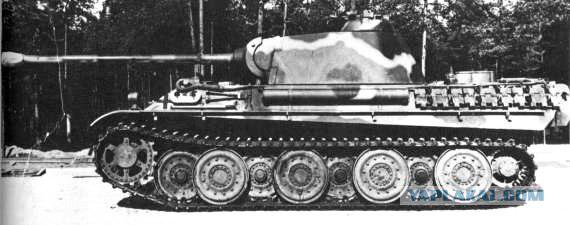
Polk «Bake», so called by the name of its commander Lieutenant Colonel Franz Beck, consisted of the 503rd Heavy Tank Battalion "Tigers" and the battalion "Panther" models D. In the course of many days of fighting with the two Soviet tank corps regiment destroyed 267 tanks, while losing This one "Tiger" and four "Panther».
The proportion of loss monstrous - 5: 267!
Polish sources, unfortunately, is not specified portion of the front, where the fighting took place said. However, you can with a high degree of credibility to suggest that the scene-Ukraine, where in January 1944 troops of the 1 st Ukrainian Front carried Zhitomir-Ber-dichevskuyu offensive. During her fierce counter-battles between 1 st and 3rd Guards Tank armies and several separate tank and mechanized corps on our part and 1, 7, 8, 19 minutes, SS "Reich" and SS "Adolf Hitler" Panzer divisions - with the German. Battles were fought over a wide area with frequent maneuvering armored units and formations on both sides. In this regard, it is unlikely that the tank regiment «Bake» Total alone fought with two same tank corps. The Germans did not have to write down on a combat regiment by the results of other parts. In any case, the sources of German shows that reports of wrecked Soviet tanks coming from the combat units Panzerwaffe, after rechecking halved. Since the conditions of constant maneuvering and counter-attacks to carry out such cross-checking it was almost impossible, it is to be above the figures of casualties on our side halve.
Nevertheless, this result is impressive - still one regiment against as many as two tank shells! Here, too, you can not do without one.
9 ...
10 ...
11 ...
12 ...
13 ...
14 ...
15 ...
16 ...
17 ...
18 ...
href="http://findpost/4311564/f...opic242488.html">findpost/4311564/f...opic242488.html.Следующая
...
...
...
...
...
...
...
...
...
...
...
...
...
...
...
...
...
Source:
18 photo and text via liveguns.ru/tanki/pantera4

2 ...

3 ...

4 ...

"Panther" - surely one of the most famous heavy tanks, took part in the Second World War. The catalyst for the creation of an unforeseen system tank weapons of the Wehrmacht war machine became a Soviet medium tank T-34. His appearance on the Eastern Front forced the Ministry of arms of Germany to suspend the work, which in 1937 led the company Nepschel on future tanks 30-ton class. July 18, 1941 Rheinmetall company received an order to develop a 75-mm long guns, able to penetrate 140 mm armor at a distance of 1000 m. On November 25, companies Daimler-Benz and MAN was, in turn, issued an order for a 35-ton tank. The performance requirements for new combat vehicle defined as follows: width up to 3150 mm height-2990 mm, engine power 650-700 hp, armor zaschita- 40 mm, maximum speed - 55 km / h. Quest received the code name - "Panther».
Tank, designed by Daimler-Benz, externally strongly resembled the T-34, but still liked Hitler. From the Soviet machine was completely copied layout with rear-engine-transmission-th branch and the drive wheels. Eight large-diameter road wheels arranged in a checkerboard pattern, blocked two and had a leaf spring as the elastic member of the suspension. Intended to be used on the tank diesel engine Daimler-Benz MB 507. In early February 1942 began the construction of a prototype - VK 3002 (DB), and four weeks later, Hitler ordered the Minister of Armaments Speer to give the company an order for the first 200 cars. However, the point of view of the Fuhrer did not find understanding and support of the Ministry of weapons experts who not without reason to believe that at the front conditions resemblance to the T-34 could cause the tank shelling of his own artillery. The project company MAN, a German who had a traditional layout with front-transmission and drive wheels, it seemed preferable, although it was much more difficult. These differences led to the formation of so-called "Panther-Commission" 13 May 1942 Hitler was informed expert opinion on both projects; This preference is clearly given to the tank company MAN. The Fuhrer was forced to agree with the experts, but then put forward its own terms: the first car to be produced in July, and the next two - in August 1942. The price of one tank without arms was 117,000 Reichsmarks (compared PzIII cost 96,163 and "Tiger" -250 800 marks).
Designers PzKpfw V (known as "Panther", without mentioning the army entered the index on the orders of the Fuhrer's only February 27, 1944) was the chief engineer of the department of MAN tank P.Vibikke and engineer G.Knipkamp of management improvement and testing of weapons.
The first two tanks V1 and V2 (V - Versuch - experience), differ from each other in minor details, produced by September 1942. November 3 one of the machines, with the layout instead of this tower, Speer demonstrated on the training ground in Bad Berka. During the tests revealed significant shortcomings in the chassis. Their elimination would take time, and this delayed the start of serial production. Order also provided to produce 250 tanks in a fairly short period of time - to May 12, 1943. In addition, it received an unexpected order to arm Hitler "Panther" 75-mm cannon with a barrel length of 100 calibers. Fortunately (for the Germans, of course), this gun was not ready and the serial production of the tank indication Fuhrer did not stop much.
The first production "Panther" left the factory workshop of MAN January 11 1943. Tanks "zero" series (20 points) received the designation Ausf A. They had nothing in common with similar machines, produced from September 1943. A characteristic feature of the first serial "Panther" was the commander's cupola with the tab on the left side of the tower and single-chamber muzzle brake gun. The tanks are equipped with engines Maybach HL210P45 and had a frontal armor thickness of 60 mm. They were used only in the rear for crew training. Since February 1943 marking machines of this series has changed on Ausf D1.
So far we can not say exactly why the first modification of the Large series "Panther" received the designation D. Perhaps the letters B and C reserved for other options.
Tanks PzKpfw V Ausf D (from this and subsequent versions of the index through notation armored Wehrmacht was the same - SdKfz171) slightly different from the prototypes and machines "zero" series. The changes affected mainly commander's cupola and gun muzzle brake - they become more familiar "panterovsky" appearance. The thickness of the frontal armor increased to 80 mm. On tanks installed and a new gearbox type AK 7-200.Sleduet noted that the machines release of the first half of 1943 was similar to the commander's cupola turret "Tiger", later it was replaced by a new one, with seven periscopes surveillance on the perimeter and a special ring installation of anti-aircraft machine gun MG 34. 5 ...

The sides of the tower were mounted mortars NbK 39 to launch smoke grenades caliber 90 mm.
Armor tanks fired in the second half, covered "tsimmeritom" In addition, they were equipped with bulwarks, made of 5-mm armor plates.
The characteristic features series machines D (officially D2) is the lack of ball set a course gun (it was placed inside the tank, and only for the shooting was inserted into a narrow vertical slit, closes the hinged lid), as well as the presence of the left side of the tower round hatches to eject spent cartridges and loopholes for shooting from the sidearms in the sides and stern bashni.V 1943 started designing another modification "Panther» - Ausf F, which is significantly different from previous models. The most important innovation was the tower, dubbed Schmalturm («narrow" or "close the tower"), which was less than the standard and had a different design.
In the course of 1944 it constructed and tested several prototypes. Designing ended only in January 1945.
As a result, the thickness of the turret was: forehead - 100 mm, board and food - 50, roof - 30. In the frontal still remained loophole for telescopic sight TZF 13. The final version of the frontal armor increased to 120 mm, on-board - to 60, and the armor of the roof - up to 40 sets a new stabilized periscope sight TZF 1 and stereoscopic rangefinder company Zeiss. Rangefinder with a base of 1320 mm and a 15-fold increase was located in front of the tower, on the sides of which were armored caps for his eyepiece. Cover and installing night vision device FG 1250.
Mask gun type Saukopfblende («pig snouts") thickness of 120 mm was similar to that applied in the tank "Tiger II».
Innovations did not pass and armament. And if the gun has remained the same and was just upgraded factories Skoda - she lost her muzzle brake and received index KwK 44/1, the MG 34 machine gun turret replaced by MG 42. Instead of a course machine gun was mounted machine MP 44. Installation weapons in the tower at the factory Krupp and Skoda.Izmeneniya affected not only the tower, but also the body. The thickness of the roof increased from 17 to 25 mm, the driver changed the hatches and arrow-radio operator.
Test and two new engines: Deutz T8M118 700 hp (515 kW) and Maybach HL 234 with direct fuel injection and 850 hp (625 kW).
By the end of the war there was not a single prototype in final form, though mass production scheduled to begin in June 1945. In the beginning, the company Daimler-Benz brought together the chassis, which established a standard turret from Ausf G. In turn, "close the tower" installed on the chassis Ausf G and tested in Kummersdorf. Total for "Panther» Ausf F produced 8 blocks and 2 towers.
In February 1943, were developed tactical and technical requirements for the tank "Panther II», involves a high degree of unification of tanks "Tiger II» and "Panther". Implement it was simply because the plants Henschel produced on both types of machines.
On the "Panther II» to be used "close the tower" and a new building. His frontal armor reached 100, onboard - 60, and aft - 40 mm. Weapons - 88-mm cannon KwK 43 L / 71. Since in this case the mass of the tank exceeds 50 tonnes, the question of a new power plant. As variants considered Maybach HL 234 engines, Simmering Sla 16 (720 hp) and MAN / Argus LD 220 (700 hp). In 1945, for the "Panther II» started designing a new tower with 150-mm frontal armor.
Neither of the two prototypes was not completed. Until more or less high degree of readiness brought one chassis, the addition of a tower from Ausf G. It is interesting to note that, in parallel with the design "Panther II» was being developed tank E-50, called her zamenit.V during work on the Ausf F and "Panther II »firm Krupp twice offered options for re-usual" Panther "cannon KwK 43 L / 71 caliber 88 mm, but to no avail. He remained on paper and draft equipment "Panther" 100-caliber 75-mm cannon with a muzzle velocity of 1250 m / s.
Along with the creation of new versions based on linear tank "Panther" was issued and several special-purpose machines. The first of these was the Armoured Recovery Vehicle (ARV) Bergepanzer V or Bergepanther (SdKfz 179). It is no accident: new tanks to enter the army, and the means for their evacuation from the battlefield almost was not. The existing machinery was too weak -for towing tank "Tiger", for example, had to "harness" two 18-ton tractor Famo.
Order BREM issued May 7, 1943, and a month later the company began producing MAN chassis Ausf D, designed to her. The first batch BREM (46 cars) did not have a crane and winch, but very soon the factory Henschel in Kassel have been designed and manufactured crane and winch with a pulling force of 40 tons and a length of rope 150 m. The selection of power produced by the engine of the tank, aft who had two folding UPR-ra-opener designed to hold the car in place when operating the winch. During the last tow blocked. The tower was replaced with a loading platform for the transport of spare parts or disassembled units.
BREM issued on the chassis Ausf A and Ausf G, had enlarged fuel tanks. The upper front hull was mounted bracket for 20-mm cannon KwK 38, veiled shield of thickness 10-15 mm.BREM-Panther & quot; originally equipped with cranes of 1500 kg, 6000 kg and then. They were used mainly for removing engines.
In front of the BREM had two stops from the tabs of solid wood, for pushing a narrower machines.
March 1st, 1944 at the site of Bad Berka Bergepanther demonstrated Inspector General armored forces, Colonel-General G.Guderianu. April 7, Hitler gave orders for the monthly production of 20 cars. However, the real issue was in April 13 vehicles in May - 18 June - 20, and in July and only 10 total factory shops left 347 Bergepanther (in foreign literature found another number - 297). 6 ...

CHASSIS. tank for a board consisted of eight dual road wheels with rubber tires with a diameter of 850 mm.
Suspension - torsion. In order to obtain a large angle of twist torsion perform double that provided the vertical movement of the support roller 510 mm. Front and rear rollers supplied with hydraulic shock absorbers.
The leading position of the front wheels have two removable gear crown 17 teeth each. Engagement lantern. Between the drive wheels and the first support roller installed a pneumatic roller.
The guide wheels - cast, with metal shrouds and crank mechanism track tensioning.
Caterpillars steel, melkozvenchatye, odnogrebnevyh of 86 tracks each. Truckee cast, width 660 mm, pitch 153 mm truck.
ELECTRICAL. It was performed on a single circuit. Voltage 12V. Sources: Generator Bosch GTLN700 12-1500BJ1 capacity 0, 7 kW, two batteries capacity of 150 Amp-hrs Bosch Consumers: electric Bosch BFD624ARS15 capacity of 4, 4 kW, control devices, lighting scopes, devices sound and light signaling, internal and external lighting, hills guns and machine guns.
MEANS OF COMMUNICATION. All tanks "Panther" is equipped with radio Fu 5, which had a range of 6, 4 and 9 km of telephone, telegraph, 4 km.
SPECIAL EQUIPMENT. Fire suppression system - automatic. Alarm was put on the dashboard of the driver.
"Panther" would be replaced by a combat soldier tanks Pz III and Pz IV, but the pace of series production did not meet the needs of the troops. In the end, the inspector general of armored troops of the Wehrmacht Col. Gen. G.Guderian after consultation with the Minister of armament A.Shpeerom decided that re-new tanks to be only one battalion in a tank regiment.
The battalion consisted of four companies of 17 tanks each. At the headquarters on 8 tanks, combat engineer platoon and a platoon of air defense, armed with self-propelled guns Mobelwagen or Wirbelwind. There was in the battalion and technical company, complete with a variety of towing vehicles and evacuation vehicles. In practice, organizations often never match the state. In parts Panzerwaffe there were an average of 51 - 54 tank "Panther", and in the Waffen SS (Waffen SS) 61-64.
The first military units who manned the "Panther", became the 51 th and 52 th tank battalions. Their formation is completed by the 15 June 1943. They made the 10th Tank Brigade (Panther-Brigade 10). As part of the SS troops also formed a team "Panther».
Overall, in mid-1943 in operation there were about 240 tanks modification D.
The operation "Citadel" was attended by 196 tanks. Their combat debut was not successful - only for technical reasons, down came the 162 "Panther". Due to lack of trucks to the Germans managed to evacuate only a small number of tanks, 127 trucks were on the territory occupied by the Red Army, and had been lost forever.
Rearmament "Panther" was going pretty intense. In many cases, this coincided with the relocation of tank units and formations, or takes them to the rear for repair and replenishment of materiel. For example, the 16th Panzer Division received new tanks in October 1943, with the transfer from Italy to Ukraine. By the end of 1943, it was rearmed one battalion in the 2, 3, 4, 7 and 19 Panzer Division; 51st battalion included in the 9th Armored Division. In the first place, "Panthers" were reported in elite connections: SS Panzer Division GroB deutschland («Greater Germany»), Hermann Goring («Hermann Goering") and others. A small number of tanks involved in educational purposes, for example, the 1st Tank School (1.Panzer Schule). In 1944, he continued the process of rearming.
Information about the combat use of "Panther" on the Eastern Front causing researchers conflicting opinions. In the cited examples in the Western press of combat episodes our tanks and self-propelled guns are burning hundreds of Germans losses as calculated units. Consider, for example, an episode connected with the actions of a heavy tank regiment «Bake» (Schwere Panzerregiment «Bake»), described in the book of the Polish author Janusz Ledvoha (where he was, no doubt, has migrated from Western sources). 7 ...

Polk «Bake», so called by the name of its commander Lieutenant Colonel Franz Beck, consisted of the 503rd Heavy Tank Battalion "Tigers" and the battalion "Panther" models D. In the course of many days of fighting with the two Soviet tank corps regiment destroyed 267 tanks, while losing This one "Tiger" and four "Panther».
The proportion of loss monstrous - 5: 267!
Polish sources, unfortunately, is not specified portion of the front, where the fighting took place said. However, you can with a high degree of credibility to suggest that the scene-Ukraine, where in January 1944 troops of the 1 st Ukrainian Front carried Zhitomir-Ber-dichevskuyu offensive. During her fierce counter-battles between 1 st and 3rd Guards Tank armies and several separate tank and mechanized corps on our part and 1, 7, 8, 19 minutes, SS "Reich" and SS "Adolf Hitler" Panzer divisions - with the German. Battles were fought over a wide area with frequent maneuvering armored units and formations on both sides. In this regard, it is unlikely that the tank regiment «Bake» Total alone fought with two same tank corps. The Germans did not have to write down on a combat regiment by the results of other parts. In any case, the sources of German shows that reports of wrecked Soviet tanks coming from the combat units Panzerwaffe, after rechecking halved. Since the conditions of constant maneuvering and counter-attacks to carry out such cross-checking it was almost impossible, it is to be above the figures of casualties on our side halve.
Nevertheless, this result is impressive - still one regiment against as many as two tank shells! Here, too, you can not do without one.
9 ...
10 ...
11 ...
12 ...
13 ...
14 ...
15 ...
16 ...
17 ...
18 ...
href="http://findpost/4311564/f...opic242488.html">findpost/4311564/f...opic242488.html.Следующая
...
...
...
...
...
...
...
...
...
...
...
...
...
...
...
...
...
Source:

